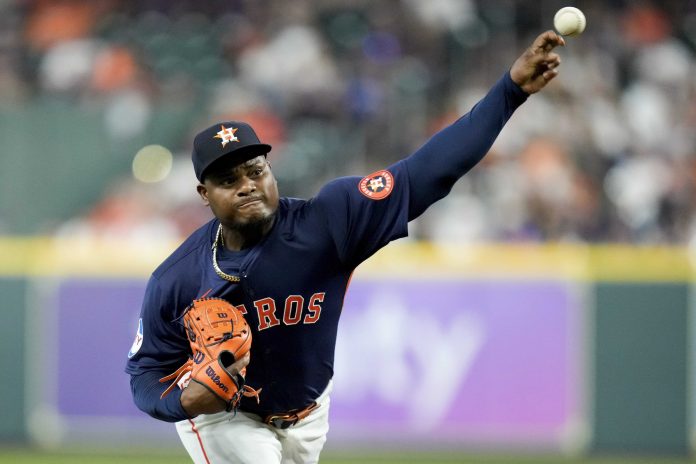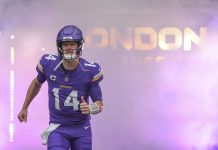
By KRISTIE RIEKEN
AP Sports Writer
HOUSTON (AP) — Houston’s Yordan Alvarez might be the top left-handed hitter in Major League Baseball. Teammate Framber Valdez ranks among the best left-handed pitchers, too.
Other than that, those guys are all right.
Literally — neither player considers himself left-handed at all.
MLB and its history are dotted with men who played out of their natural handedness, a phenomenon that is seen occasionally in other sports but is a regular occurrence on the diamond. Thumb through a pack of baseball cards from just about any era and you’re likely to see players who bat one way and throw the other. Ask them to sign that card and there’s no telling which hand would hold the pen.
Valdez writes, eats and even hits (before the introduction of the universal designated hitter) with his right hand. His left arm has helped him make two All-Star teams and throw a no-hitter. What else does he use it for?
“Nothing, nothing, nothing,” he said with a laugh.
Valdez simply decided at a young age that he wanted to be a left-handed pitcher.
“I used to throw lefty every single day, like day by day by day,” he said in Spanish through a translator. “When I was 11, I felt very comfortable throwing lefty, even though I did everything else righty.”
Lefties accounted for around 26% of innings pitched in the majors last year, even though only 10-12% of the general population is estimated to be left-handed. Demand for good lefty pitchers is high, and Valdez recalls having an affinity for all of them.
“When I was growing up, I was always told that it is very important to have a lefty pitcher, that all the best pitchers were lefties as well,” he said. “So, I told myself: ‘Hey, I want to be a lefty.'”
Alvarez throws, writes and eats with his right hand — that sweet, powerful swing is his only left-handed activity. Like many young players, he aspired to be a switch-hitter. Oddly, he ended up more comfortable on his non-dominant side.
“But I just got accustomed to hitting left-handed,” he said via translator. “And it was very interesting because my dad is the same thing. He hits left-handed, but he does everything else right-handed.”
Players like Alvarez are common across the majors, with 95 position players currently on active rosters listed as batting left and throwing right, including superstar two-way player Shohei Ohtani.
Houston has the only two position players in the league who throw left and bat right in outfielders Chas McCormick and Jake Meyers.
“My dad throws left and hits right so that’s what I do, too,” Meyers said. “I picked up a baseball with my left hand and started throwing it and picked up a bat and wanted to swing right-handed and that’s kind of what he believed and now I’m here. Chas McCormick is the only other guy I’ve played with that does that.”
Toronto outfielder George Springer, a righty hitter and thrower, startled teammate Justin Turner this spring by writing with his left hand.
“It’s really weird,” Turner said. “I saw him sign an autograph the other day and I was like, ‘What the hell are you doing?'”
Springer, the 2017 World Series MVP, calls himself left-handed and says the only things he does righty are play baseball and golf. His parents tell him he started grabbing the ball with his right hand at a young age and stuck with it.
“That’s just who I am,” Springer said. “I’ve never really thought anything of it. I guess it is cool that I can do things with each side of my body and I’m not so one-way dominant.”
Dr. Stephen D. Christman, a professor in the psychology department at the University of Toledo and an expert in handedness, said cases like Springer’s aren’t that surprising.
“It’s easier for a lefty to learn to use their right hand than for a righty to learn to use their left hand because most left-handers lean more towards being ambidextrous,” said Christman, who has studied handedness for more than two decades.
Christman said studies have found only 1-2% of people are uniformly left-handed across the 10 activities used to measure handedness, including writing, drawing, throwing, brushing teeth and hair, opening a box and using a spoon. Because lefties are forced to adapt — like when only righty scissors are available — they’re more likely to learn to use both hands.
Though it’s rare in other sports for guys to play out of their natural handedness, there is a huge exception in the NBA. Superstar LeBron James is like Springer in that he’s naturally left-handed but plays right-handed. James, who turns 40 in December, joked about his handedness late last year.
“I’m gonna play until I’m 40. Then, after 40, I’m gonna go all left-hand until I’m 45,” he joked to reporters. “I’m gonna score 5,000 points with my left hand. Then I’ll be done.”
Valdez, Alvarez and Springer follow in a line of great MLB players who played out of their natural handedness. The list even includes Babe Ruth, who batted and threw left-handed but can be seen in photos using his right hand to sign autographs. John Thorn, MLB’s official historian, says Ruth was naturally left-handed, but teachers at the time routinely discouraged children from writing with their left hand because lefties were “thought to represent the dark side.”
Though not for the same reasons, Houston first baseman Jon Singleton ended up doing the same thing as Ruth. He both bats and throws left-handed but writes with his right hand.
“My mom’s a school teacher, and she taught me how to write with my right hand when I was young, and I think that translated to me eating with my right hand so on and so forth,” he said. “But for the most part, I think I’m left-handed.”
Though things might come easier for elite athletes, Christman said anyone can learn to do things with their non-dominant hand.
“I think practice can overcome any innate handedness difference just about,” he said.
















